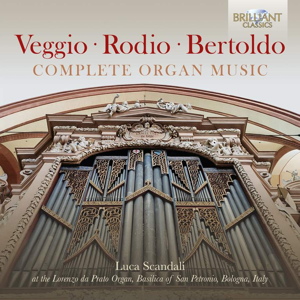
Claudio Veggio (c1510-after 1543)
Rocco Rodio (c1530/40-after 1615)
Sperindio Bertoldo (c1530-1570)
Complete Organ Music
Luca Scandali (organ)
Mauro Morini (sackbut)
rec. 2020, Basilica of San Petronio, Bologna, Italy
BRILLIANT CLASSICS 95804 [2 CDs: 100]
The basilica of San Petronio in Bologna is the proud owner of two historical organs, on both sides of the altar. The oldest dates from 1471-75, the youngest from 1531. It is not surprising that they are frequently used for recordings of renaissance and early baroque keyboard music, also thanks to their meantone temperament and the fact that some of the keys are split. The former instrument, on the right side of the altar, is the one that Luca Scandali chose to record a programme of works by three composers. Even organ aficionados may never have heard of Claudio Veggio, Rocco Rodio and Sperindio Bertoldo.
Claudio (Maria) Veggio worked in Piacenza, where he was part of the Accademia Ottolana, a circle of artists and intellectuals. He published only one collection of music, a book with madrigals which he dedicated to his patron, Count Federico Anguissola. His keyboard works are included in the Manoscritto di Castell’Arquato, one of the earliest and most important collections of Italian keyboard music from the first half of the 16th century. Notable are the various number of staves within single works, and the fact that Veggio made revisions and corrections, which gives the impression that it was a work in progress. According to New Grove it includes eight ricercares, but the present recording has only six. The difference is not explained in the liner-notes. They are of very different length, varying from 41 to 147 breves (bars). In these pieces contrapuntal and figurative sections alternate. La fugitiva is a keyboard transcription of a piece for instrumental ensemble.
Rocco Rodio was from Bari in the Apulia region, on the Adriatic Sea in southern Italy. For most of his life he worked in Naples, where he was a member of Carlo Gesualdo’s academy. He may have been in close contact with Spanish composers, such as Diego Ortiz. His first printed edition was a collection of masses, published in Rome in 1562. In 1587 he published a book with madrigals in Venice. The present disc includes five ricercatas which were printed in Naples in 1575. It also contains some fantasias: two on liturgical chants (Ave maris stella, Iste confessor) and one on a sequence of notes: La mi re fa mi re, which is also known under different titles, such as La Spagna. The fourth fantasia, on the Salve Regina, was included in the collection Intavolatura de Cimbalo of Antonio Valente, one of the main representatives of the Neapolitan keyboard school. I have to mention here that the English translation suggests that the sequence of notes is the basis of the fantasia on Salve Regina, but that is not the case.
Sperindio Bertoldo was born in Modena. From 1552 until his death he acted as organist at the Cathedral of Padua. He published two collections of madrigals, and some of his madrigals are included in anthologies. He left ten keyboard works, which were published after his death in two separate books. The first came from the press in 1591 and comprises four canzoni francese, which are intabulations of some of the most popular French chansons of the time. They include trills and rapid scale passages in both hands. Stylistically they are close to the instrumental passaggi of the time. The diminution practice was popular and wide-spread. The second edition comsists of six pieces: another canzon francese which seems not to have a vocal origin, as well as two toccatas and three ricercares. The two toccatas are largely contrapuntal and omit florid passages. The three ricercares are either monothematic or move in that direction. Two of them are intabulations of excerpts from four-part ricercares by Annibale Padovana.
This recording demonstrates the variety in forms and style of keyboard music in a time of constant change and development. The three composers represent voices of their own in the large chorus of keyboard composers. The impact of this repertoire strongly depends on the instruments on which they are played. Luca Scandali could not have made a better choice than the oldest of the two organs in San Petronio. He effectively explores its colour palette in his registrations, and in his choice of tempi deals well with the reverberant acoustic of the basilica. It was a nice idea to include a sackbut, playing the plainchant melodies in Rodio’s fantasias.
Johan van Veen
www.musica-dei-donum.org
twitter.com/johanvanveen
Help us financially by purchasing from



Contents
CD 1
Claudio Veggio (c1510-after 1543)
Recercar del primo tono
Recercada prima del primo tono per b molle
Recercar del quinto tono per b molle (ed. Luca Scandali)
La fugitiva
Recercada per b quadro del quarto tono
Recercada per b mol del primo tono
Recercada per b quadro del primo tono
Rocco Rodio (c1530/40-after 1615)
Ricercata prima
[Fantasia sopra] Ave maris stella*
Seconda ricercara
[Fantasia sopra] Salve Regina*
Terza ricercata
[Fantasia sopra] La mi re fa mi re [La Spagna]
CD 2
Quarta ricercata
[Fantasia sopra] Iste confessor*
Quinta ricercata
Sperindio Bertoldo (c1530-1570)
Toc[c]ata prima
Ricercar del primo tuono
Hor vienza vien (Janequin: Or vien ça vien)
Ricercar del terzo tuono
Canzon francese
Un gai berger (Crecquillon)
Petit fleur (Janequin)
Ricercar del sesto tuono
Frais et gagliard (Clemens non Papa: Frisque et gaillard)
Toc[c]ata seconda
(*) with sackbut


















